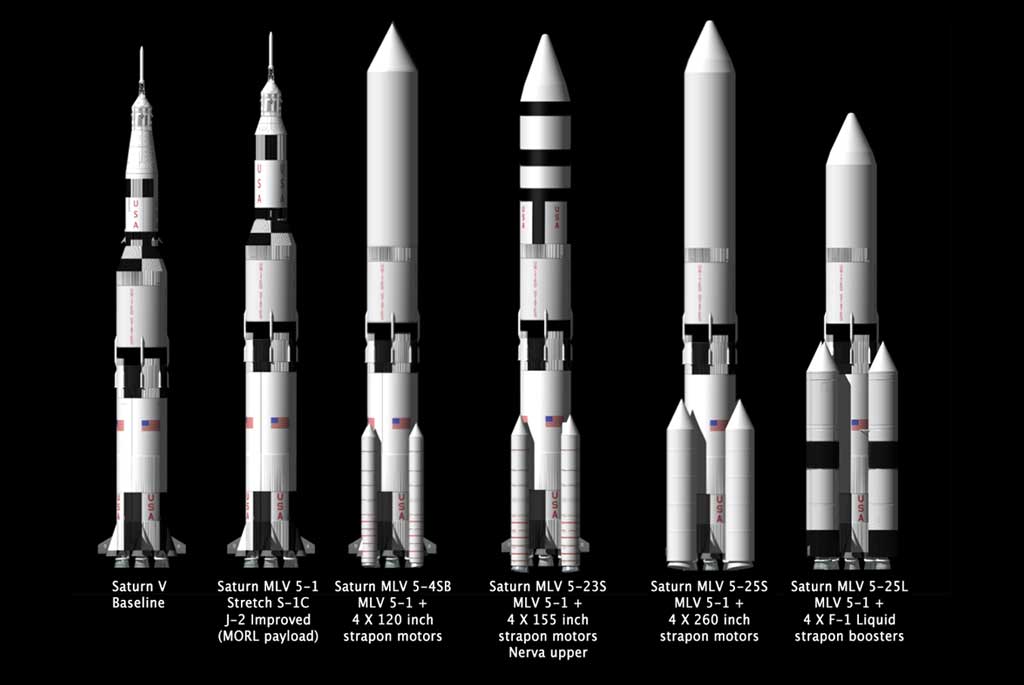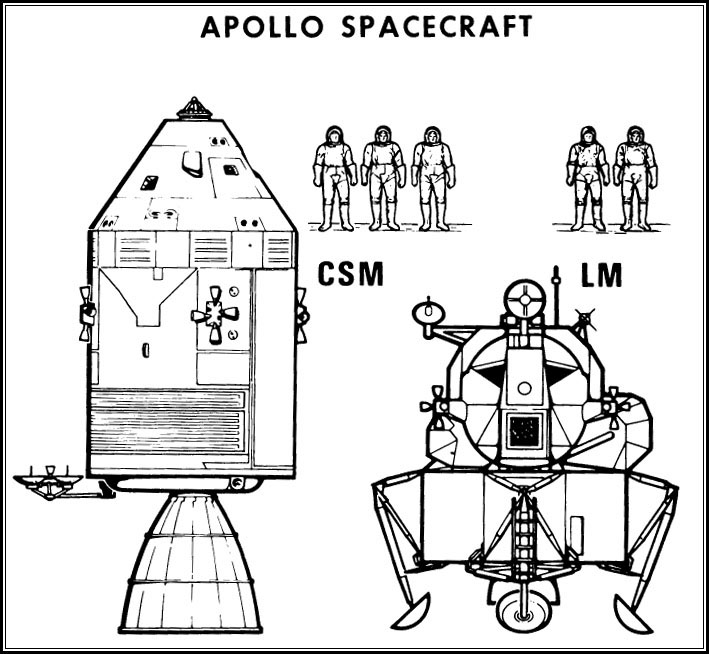Saturn V Rockets & Apollo Spacecraft
The Apollo missions were the answer to a challenge issued by President John F. Kennedy to put a man on the moon. But just to get there, scientists had to build a powerful rocket. And to actually land on the moon and return the astronauts safely, NASA had to develop new spacecraft and a new type of rocket.
NASA ultimately decided on a solution that consisted of three parts: A lunar lander (known as the lunar module) would put humans on the moon. A command module would bring the astronauts to the moon (lunar module attached) and back home. And the Saturn V rocket would provide enough power to propel both lander and command module into Earth orbit to prepare for their moon journey.

Saturn V rocket
NASA developed the Saturn V rocket to meet the challenge of launching people to the moon. At 363 feet (111 meters), it was taller than a 36-story building and was the largest, most powerful rocket ever launched. Powered by five engines in each of its first two stages, the rocket produced 7.5 million pounds of thrust at liftoff. [Apollo 11 Moon Rocket's F-1 Engines Explained (Infographic)]
The Saturn V moon rocket had three expendable stages. In the configuration that sent astronauts to the moon, the first stage used liquid oxygen and kerosene, the second stage used liquid hydrogen and liquid oxygen and the third stage used liquid hydrogen and liquid oxygen.
Each stage lifted the rocket until that stage's fuel was expended. The first stage shot the rocket up about 42 miles (68 kilometers) and the second stage carried the rocket even closer to orbit. The third stage placed the Apollo spacecraft into Earth orbit and pushed it toward the moon. The first two stages fell into the ocean after separation, while the third stage either stayed in space or hit the moon.
Fifteen Saturn V rockets were built, and only two were tested without a crew. The first Saturn V to launch with a crew was Apollo 8, which set off in December of 1968. In July of 1969, a Saturn V launched the crew of Apollo 11 to the first crewed landing on the moon. Saturn V rockets carried six more moon missions into space: Apollos 12 through 17, between 1969 and 1972. A two-stage Saturn V also lifted the Skylab space station into orbit in May 1973. Three remaining, unused Saturn V rockets are on display at the NASA Johnson Space Center in Texas, the NASA Kennedy Space Center in Florida, and the U.S. Space & Rocket Center in Alabama.

Apollo spacecraft
Sitting atop the Saturn V rocket was the Apollo spacecraft, which had three components: the service module, the command module spacecraft and the lunar module spacecraft.
The service module provided power, propulsion and storage to the command module. It was cylindrical, at 24.6 feet (7.5 m) long and 12.8 feet (3.9 m) in diameter. It contained fuel tanks and oxygen/hydrogen tanks and housed the fuel cells that provided most of the power for the crew compartments. For most of the mission, the service module and command module were attached, with the units sometimes referred to as a single craft: the command-service module.
The command module housed the astronauts. It was 10.6 feet (3.2 m) tall and 12.8 feet (3.9 m) wide at its base. Inside, the astronauts had about 210 cubic feet (6 cubic m) in which to move around — about the space in a car's interior. The command module was the only part of the spacecraft that would return to Earth. It re-entered the atmosphere with its heat shield facing the planet, to defend against the high temperatures caused by atmospheric friction.
As the mission approached the moon, the command module separated from the lunar module. One astronaut stayed in orbit aboard the command module, while the other two descended to the lunar surface in the lunar module.
The lunar module was 23 feet (7 m) tall and 14 feet (4 m) wide and had two sections: the upper ascent stage and the lower ascent stage. The upper stage carried the crew, equipment and an ascent rocket engine; the lower stage had the landing gear, lunar surface experiments and the descent rocket engine. When the mission was over, the lower stage provided a launch platform and was left on the moon. The upper stage rendezvoused with the command module and was jettisoned after the astronauts were reunited.
During Apollo 13 in April 1970, the lunar module served as a temporary lifeboat after an explosion damaged the command module and service module; all three astronauts returned safely to Earth.
Today, the command modules for all of the Apollo missions are on display at various museums. The lunar module lower stages are mostly on the surface of their respective landing sites on the moon. The upper stages were either deliberately crashed into the moon or sent into orbit around the sun. An exception is Apollo 13's lunar module, which was needed to bring the astronauts back home; it burned up naturally in Earth's atmosphere during the descent.
Between 2018 and 2021, NASA is celebrating the 50th anniversary of the various Apollo missions. The largest celebration will likely come on July 20, 2019, when NASA celebrates the 50th anniversary of the Apollo 11 landing.
This article was updated on Oct. 17, 2018 by Space.com Contributor, Elizabeth Howell.
Join our Space Forums to keep talking space on the latest missions, night sky and more! And if you have a news tip, correction or comment, let us know at: community@space.com.
Get the Space.com Newsletter
Breaking space news, the latest updates on rocket launches, skywatching events and more!











